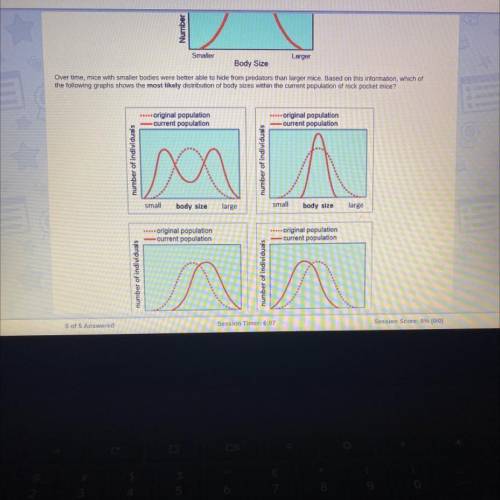
Biology, 28.01.2021 03:20 blackwelle72
The rock pocket mouse (Chaetodipus intermedius) is a species of rodent commonly found in the deserts of Mexico and the
southwestern United States. Suppose a population of rock pocket mice lives in an area of rocky terrain. The graph below shows the
distribution of body sizes within the population at the time the mice began to live among the rocks.
Number of Individuals
Smaller
Larger
Body Size
Over time, mice with smaller bodies were better able to hide from predators than larger mice. Based on this information, which of
the following graphs shows the most likely distribution of body sizes within the current population of rock pocket mice?


Answers: 1


Another question on Biology

Biology, 22.06.2019 08:00
Biology ! the conversion of inorganic carbon to organic carbon by plants during photosynthesis is known as _[blank]_. filtration immigration reabsorption primary production
Answers: 1

Biology, 22.06.2019 16:30
What amount of heat is exchanged when 106.2 grams of substance y goes from a liquid at 35 degrees
Answers: 3

Biology, 22.06.2019 23:40
Which base is found only in rna? ribose othymine ouracil o deoxyribose detecteet
Answers: 1

Biology, 23.06.2019 04:00
Aresearcher discovered a species of moth that lays its eggs on oak trees. eggs are laid at two distinct times of the year: early in spring when the oak trees are flowering and in midsummer when flowering is past. caterpillars from eggs that hatch in spring feed on oak flowers and look like oak flowers. but caterpillars that hatch in summer feed on oak leaves and look like oak twigs.how does the same population of moths produce such different-looking caterpillars on the same trees? to answer this question, the biologist caught many female moths from the same population and collected their eggs. he put at least one egg from each female into eight identical cups. the eggs hatched, and at least two larvae from each female were maintained in one of the four temperature and light conditions listed below.in each of the four environments, one of the caterpillars was fed oak flowers, the other oak leaves. thus, there were a total of eight treatment groups (4 environments × 2 diets).which of the following is a testable hypothesis that would explain the differences in caterpillar appearance observed in this population? a) winter causes ugly caterpillar and trees.b) differences in diet trigger the development of different types of caterpillars.c) the longer day lengths of summer trigger the development of twig-like caterpillars.d) differences in air pressure, due to differences in elevation, trigger the development of different types of caterpillars.
Answers: 3
You know the right answer?
The rock pocket mouse (Chaetodipus intermedius) is a species of rodent commonly found in the deserts...
Questions

Arts, 26.06.2019 12:20


History, 26.06.2019 12:20



Physics, 26.06.2019 12:20


Physics, 26.06.2019 12:20

Physics, 26.06.2019 12:20

History, 26.06.2019 12:20

English, 26.06.2019 12:30

Physics, 26.06.2019 12:30


English, 26.06.2019 12:30

Mathematics, 26.06.2019 12:30


Chemistry, 26.06.2019 12:30

History, 26.06.2019 12:30


Biology, 26.06.2019 12:30



